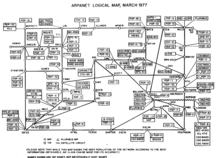Web Development/The history of the Internet
| Section 1.1 — Back to Contents |
Beginnings of the Internet
[edit | edit source]Memex
[edit | edit source]In 1945 Vannevar Bush hypothesized a device known as memex, a mechanized index of all human knowledge.
ARPANET
[edit | edit source]
Starting in 1969 the Military project ARPANET became one of the first networks to use the TCP/IP protocol and packet switch networking.
Engelbart
[edit | edit source]Engelbert's ARC and Xerox PARC, the Mother of All Demos, Engelbert's ethernet, hyper-text.
Today's Internet
[edit | edit source]Apart from the incredibly complex physical connections that make up its infrastructure, the Internet is held together by bi- or multi-lateral commercial contracts (for example peering agreements) and by technical specifications or protocols that describe how to exchange data over the network.
Unlike older communications systems, the Internet protocol suite was deliberately designed to be agnostic with regard to the underlying physical medium. Any communications network, wired or wireless, that can carry two-way digital data can carry Internet traffic. Thus, Internet packets flow through wired networks like copper wire, coaxial cable, and fiber optic; and through wireless networks like Wi-Fi. Together, all these networks, sharing the same high-level protocols, form the Internet.
The Internet protocols originate from discussions within the Internet Engineering Task Force (IETF) and its working groups, which are open to public participation and review. These committees produce documents that are known as Request for Comments documents (RFCs). Some RFCs are raised to the status of Internet Standard by the Internet Architecture Board (IAB).
Some of the most used protocols in the Internet protocol suite are IP, TCP, UDP, DNS, PPP, SLIP, ICMP, POP3, IMAP, SMTP, HTTP, HTTPS, SSH, Telnet, FTP, LDAP, SSL, and TLS.
Some of the popular services on the Internet that make use of these protocols are e-mail, Usenet newsgroups, file sharing, the World Wide Web, Gopher, session access, WAIS, finger, IRC, MUDs, and MUSHs. Of these, e-mail and the World Wide Web are clearly the most used, and many other services are built upon them, such as mailing lists and web logs. The Internet makes it possible to provide real-time services such as web radio and webcasts that can be accessed from anywhere in the world.
Some other popular services of the Internet were not created this way, but were originally based on proprietary systems. These include IRC, ICQ, AIM, and Gnutella.
There has been much analysis of the Internet and its structure. For example, it has been determined that the Internet IP routing structure and hypertext links of the World Wide Web are examples of scale-free networks.
Similar to how the commercial Internet providers connect via Internet exchange points, research networks tend to interconnect into large subnetworks such as:
- GEANT
- Internet2
- Little GLORIAD
These in turn are built around relatively smaller networks.
